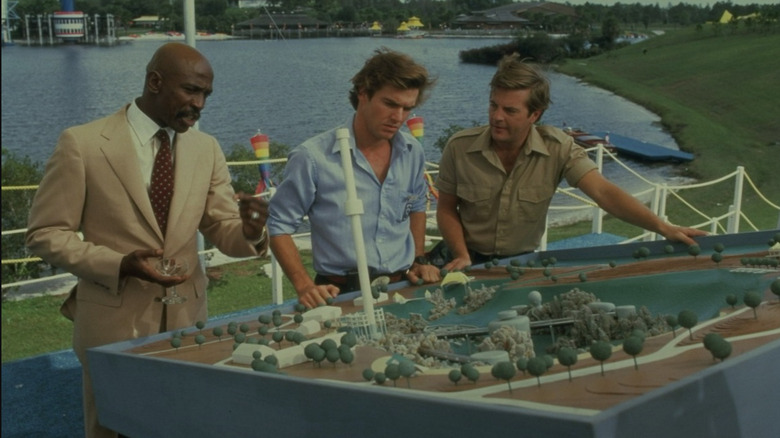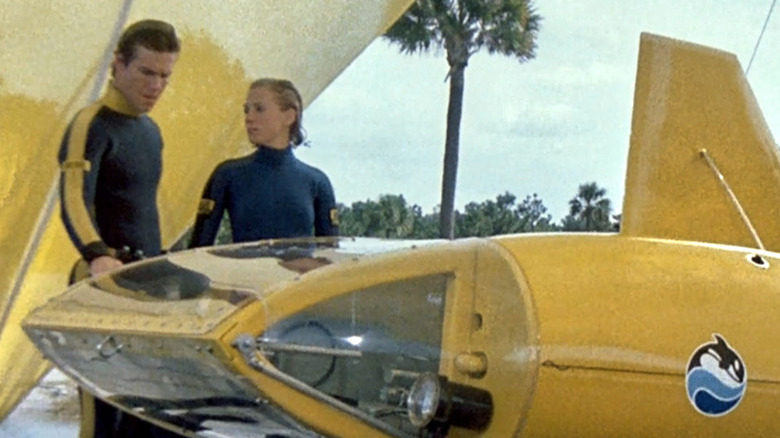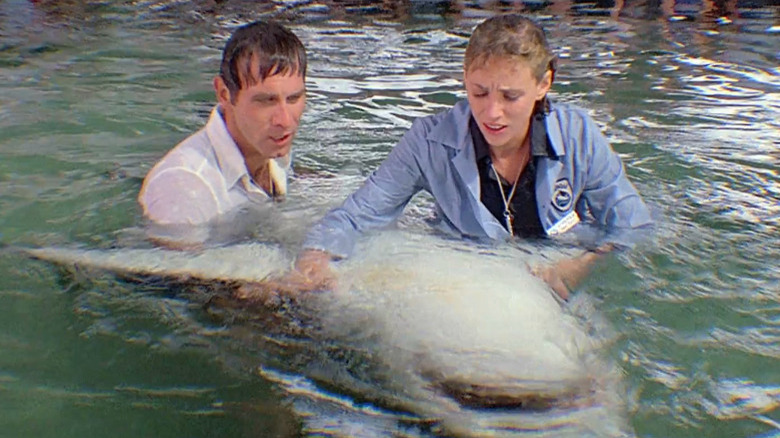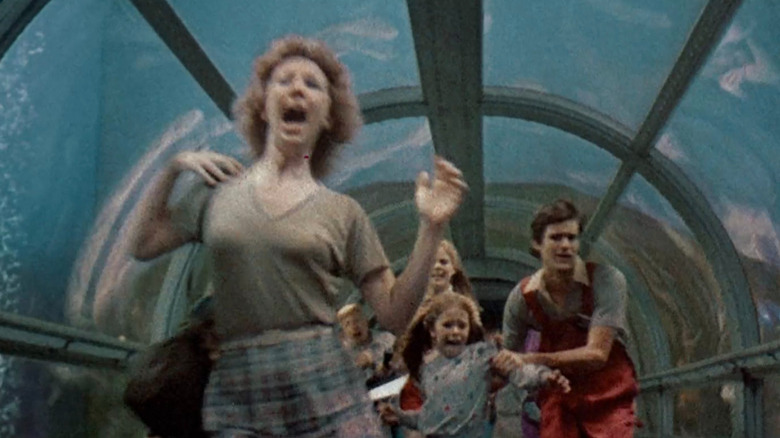Jaws 3-D Tried To Warn Us About SeaWorld
Have you ever wondered why in the 2023 version of "The Haunted Mansion," Owen Wilson is shown eating a big bag of Burger King and telling Lakeith Stanfield that the fast food chain's fried snacks are literal messages from heaven? Or why while Rambo is being told about his off-the-books, super-secret, clandestine mission to rescue POWs from Vietnam in "Rambo: First Blood Part II," the scene gets interrupted by his superior officer purchasing a Coca-Cola from the Coca-Cola vending machine that he inexplicably has in his office?
The answer is a little thing called product placement, in which various companies selling various products frequently exchange money with motion picture and/or television studios to display their products prominently on-screen. That's probably why in "Fantastic Four: Rise of the Silver Surfer," when Reed Richards presents the famous flying FantastiCar from the comic books that he built all by himself in his private lab, it somehow has the Dodge logo on it. (The Human Torch even asks if it's got a HEMI, to which Mister Fantastic replies, "Of course!")
Product placement can be subtle. Product placement can be blatant. Product placement can even insult the audience's intelligence. But it's extremely rare for product placement to insult the actual product itself and say that it's not only bad, but it's probably guilty of criminal negligence.
This brings us to "Jaws 3-D," a film that takes place at the real-life SeaWorld amusement park in Orlando, and makes SeaWorld out to be a villainous organization that's responsible for many, many deaths.
Sharks and recreation
"Jaws 3-D" was a joke even before it came out. The producers of the film originally pitched it not as a horror movie, but as a spoof entitled "Jaws 3, People 0." Development on the comedy version got as far as the screenplay, which was co-written by the legendary John Hughes, writer of "Home Alone," "National Lampoon's Vacation," and a slew of 1980s teen classics. (Incidentally, I've read the screenplay for "Jaws 3, People 0" and the title was the funniest part of it.)
Instead, Universal backed another, somewhat serious sequel about the Brody family getting attacked by yet another giant Great White Shark. Roy Scheider, who played Chief Martin Brody in the first two films, said "Mephistopheles ... couldn't talk [him] into" making "Jaws 3-D," and even went out of his way to co-star in the helicopter thriller "Blue Thunder" just to make sure he was contractually obligated to be somewhere else while this sequel was being made.
The film stars Dennis Quaid and John Putch ("One Day at a Time") as Brody's sons, Mike and Sean. Mike is now the chief engineer at SeaWorld Orlando and dating the park's head biologist, Kay (Bess Armstrong, "My So-Called Life"). Sean is visiting for the summer and starts dating one of SeaWorld's many, many, many water skiers ("Back to the Future" star Lea Thompson, making her big screen debut), but is still afraid to get in the water after the whole, you know, "Jaws" thing.
The plot is about a brand new SeaWorld attraction, "The Undersea Kingdom," where guests can walk in underwater tubes among the fishies. But a problem arises when a Great White Shark sneaks into the park, kills a lot of people, and wreaks untold havoc. And it's all thanks, almost exclusively, to SeaWorld's extreme negligence.
It's a bad, bad, bad, bad SeaWorld
It's hard to keep track of how many times "Jaws 3-D" explicitly calls attention to the fact that it's shot at SeaWorld, from hero shots of Shamu the Orca, to people in Shamu costumes walking through the park, to all the logos emblazoned everywhere, to the times it simply comes up in dialogue. It's also hard to keep track of how many times the plot of "Jaws 3-D" implicates SeaWorld in various forms of (likely criminal) negligence.
The first victim in the film gets eaten by a shark because SeaWorld wouldn't pay overtime, so they were doing their job underwater without safety precautions and off the books. Later on, that character's severed head pops up in The Undersea Kingdom, having gone unnoticed for days, traumatizing families, including one poor girl whose face gets pressed up against the glasses, barely an inch from the bloated corpse, in all the panicked chaos.
When the park manager, Calvin (Louis Gossett Jr., in his first role after winning an Oscar for "An Officer and a Gentleman"), finds out there's a shark loose in the park, he first plans to hunt it down and kill it for the audience's amusement. When he's talked into capturing the shark isntead, he ignores Kay's advice and rushes it in front of the visitors in a tiny tank that kills the poor creature within minutes.
When that shark's mom turns up, understandably pissed, it wrecks The Undersea Kingdom. As it turns out, the attraction has "safety precautions" that trap the visitors inside airtight rooms where they almost suffocate to death. And while the shark rampages, the only system the park has of warning people seems to be Mike, and only Mike, running through SeaWorld yelling at people. Eventually Calvin gets on the intercom to announce the park was closing, which he couldn't do earlier for reasons the authorities and the stockholders will probably want to know.
A discovery of fishes
It's extremely rare for any movie to show a real product in a negative light. It's also rare for a film that takes place within a real, still-functioning business or institution to confront any of the actual bad things that the company has really done, let alone say they're directly responsible for a bunch of made-up stuff. For example, Ben Affleck's "Air" takes place at Nike and treats Nike employees like plucky protagonists, only mentioning the company's history of sweatshop labor once, in a single sentence, before quickly pivoting to trying to make us care more about Jason Bateman's character buying his daughter's love with sneakers than, you know, the sweatshop labor.
"Jaws 3-D" is a film that actively seems to hate SeaWorld and constantly strives to show how terrible it is, and you know what? Time has been kind to "Jaws 3-D." That's partly because — even though it's a silly film in some ways as the 3-D gags are laughable and some of the VFX are bad — it's fast-paced, the cast is likable, the shark kills are fun, and the cheesiest moments are enjoyably kitschy. If it didn't have "Jaws" in the title it would probably be fondly remembered.
But it's mostly because "Jaws 3-D" was a little ahead of the curve on the SeaWorld thing. No, the park never got people killed by mishandling shark attacks, but the acclaimed 2013 documentary "Blackfish" raised serious concerns about the way the park treated its famous orcas, seriously damaging the company's public perception and stock prices, and leading to major changes in the park's policies. This led to the film "Paper Towns" cutting a scene set at SeaWorld, and "Finding Dory" changing its ending to distance itself. And even though, years later, SeaWorld is still around and seems to have recovered, "Jaws 3-D" will always remind us of a time when it seemed like something was fishy.



